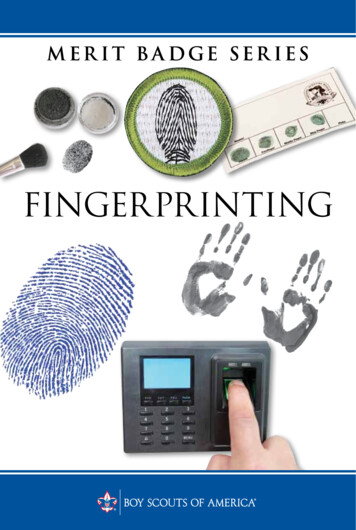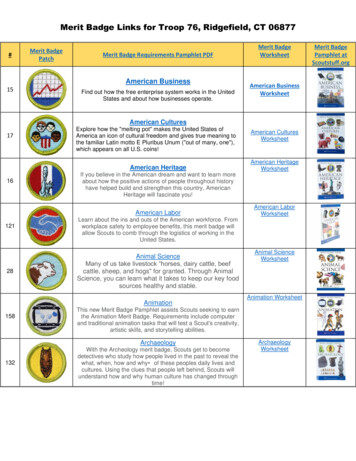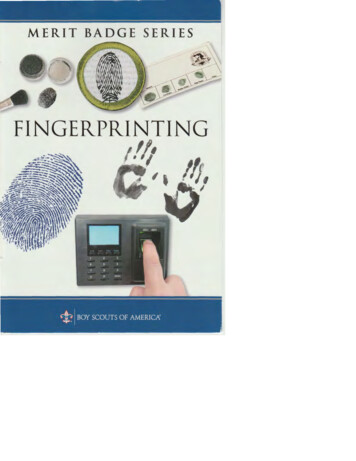
Transcription
FINGERPRINTING
BOY SCOUTS OF AMERICAMERIT BADGE SERIESFINGERPRINTING“Enhancing our youths’ competitive edge through merit badges”
Requirements1. Give a short history of fingerprinting. Tell the differencebetween civil and criminal identification.2. Explain the difference between the automated fingerprintidentification systems (AFIS) now used by law enforcementagencies and the biometric fingerprint systems used tocontrol access to computers and places like buildingsand airports.3. Do the following:a. Name the surfaces of the body where friction orpapillary ridges are found.b. Name the two basic principles supporting thescience of fingerprints and give a brief explanationof each principle.c. Explain what it takes to positively identify a personusing fingerprints.4. Take a clear set of prints using ONE of thefollowing methods.a. Make both rolled and plain impressions. Make these onan 8-by-8-inch fingerprint identification card, availablefrom your local police department or your counselor.b. Using clear adhesive tape, a pencil, and plain paper,record your own fingerprints or those of another person.5. Show your merit badge counselor you can identify the threebasic types of fingerprint patterns and their subcategories.Using your own hand, identify the types of patterns you see.35895ISBN 978-0-8395-3287-3 2014 Boy Scouts of America2016 Printing
Fingerprinting Resources .Fingerprinting ResourcesScouting LiteratureChemistry, Crime Prevention, Law, andPhotography merit badge pamphletsFor more information about or toorder Scouting-related resources,see http://www.scoutstuff.org(with your parent’s permission).BooksBeavan, Colin. Fingerprints: TheOrigins of Crime Detection and theMurder Case that Launched ForensicScience. Hyperion, 2002.Beres, D.B. Dusted and Busted! TheScience of Fingerprinting. Children’sPress, 2007.Bertino, Anthony J., and PatriciaBertino. Forensic Science:Fundamentals and Investigations,2nd ed. Cengage Learning, 2015.Camenson, Blythe. Opportunities inForensic Science Careers, 2nd ed.McGraw-Hill, 2008.Deslich, Barbara, and John Funkhouser.Forensic Science for High School, 2nded. Kendall Hunt, 2009.Evans, Colin. The Casebook of ForensicDetection: How Science Solved 100of the World’s Most Baffling Crimes,updated ed. Berkley Trade, 2007.34 FINGERPRINTINGJones, Charlotte Foltz. Fingerprints andTalking Bones: How Real-Life CrimesAre Solved. Yearling Books, 1999.Jones, Gary W. Introduction toFingerprint Comparison.Staggs, 2000.Rainis, Kenneth G. Crime-SolvingScience Projects: Forensic ScienceExperiments. Enslow, 2005.Schulz, Karen K. CSI Expert!Forensic Science for Kids.Prufrock Press, 2008.Siegel, Jay. Forensic Science: ABeginner’s Guide. OneworldPublications, 2009.Thompson, Robert Bruce, and BarbaraFritchman. Illustrated Guide toHome Forensic Science Experiments.Maker Media Inc., 2012.Vacca, John. Biometric Technologiesand Verification Systems.Butterworth-Heinemann, 2007.Walker, Pam, and Elaine Wood.Crime Scene Investigations: RealLife Science Labs for Grades 6–12.Jossey-Bass, 2000.Wiese, Jim. Detective Science: 40Crime-Solving, Case-Breaking, CrookCatching Activities for Kids. JohnWiley and Sons, 1996.
.Fingerprinting ResourcesYoung, Karen Romano. Science FairWinners: Crime Scene Science.National Geographic Kids, 2009.Organizations and WebsitesFBI YouthWebsite: http://www.fbi.gov/fun-games/kids/kidsLatent Print Examination:Fingerprints, Palm Prints,and FootprintsWebsite: http://onin.com/fpYoung Forensic Scientists ForumWebsite: http://yfsf.aafs.orgAcknowledgmentsFor assistance with updates to theFingerprinting merit badge pamphletand the requirements, the Boy Scoutsof America thanks Ed German, acertified latent print examiner (CLPE)who works on fingerprint evidencecases for American military investigators from his office at the U.S. ArmyCriminal Investigation Laboratory.Special Agent German serves as aFingerprinting merit badge counselor.The BSA also thanks Lisa VincentStout, art and information specialist,Criminal Justice Information ServicesDivision, Federal Bureau of Investigation;and Charles Jones, training supervisor,Identification and InvestigativeServices Section, FBI. Thanks also toWRB Fingerprint Counseling Service,Springfield, Virginia, and to the policedepartments of Edison and NewBrunswick, New Jersey, for theirpast assistance.The Boy Scouts of America isgrateful to the men and women serving on the Merit Badge MaintenanceTask Force for the improvements madein updating this pamphlet.Photo and Illustration CreditsCoppell, Texas, Police Department,courtesy—page 17 (both)HAAP Media Ltd., courtesy—cover(handprints, blue fingerprint, dusting brush/powder/print)Shutterstock.com, courtesy—cover(finger scan, chungking); pages 3( Maksim Kabakou), 4 ( Axstokes),20 ( Vector Icon), 24 ( siebenia),25 (forensic scientist, LeahAnne Thompson), 28 ( TetianaYurchenko), 32 ( Black Jack), and33 ( Johan Swanepoel)All other photos and illustrations notmentioned above are the property of orare protected by the Boy Scoutsof America.Dan Bryant—cover (fingerprint card)John McDearmon—pages 6, 7, 8,and 16FINGERPRINTING 35
Fingerprinting merit badge pamphlet and the requirements, the Boy Scouts of America thanks Ed German, a certified latent print examiner (CLPE) who works on fingerprint evidence cases for American military investiga-tors from his office at the U.S. Army Criminal Investigation Laboratory. Special Agent German serves as a Fingerprinting merit badge counselor. The BSA also thanks Lisa Vincent .









